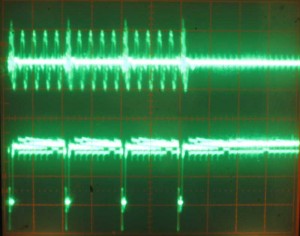I’ve noticed long ago that there is a significant amount of noise on the -5 volt supply on the Apple 1. The -5 power supply is connected to 16 4096 DRAMs, 7 2504v shift registers, and the 2513 character generator, 24 chips in all, spread around the board. Beside a 22UF cap next to the voltage regulator, there is only 1 .1UF decoupling cap connected to this supply.
Here is an oscilloscope picture of this noise. Frequency of this trace is set to 5 micro-seconds/division. Top trace is -5 taken directly from a DRAM chip. Scale is .5 volts per division. Bottom trace is RAS taken from same DRAM chip. Scale is 2 volts per division. You can see that some of the noise on the -5 supply is being generated directly by RAS switching. This working system exhibits over a .5 volts of noise on the -5 supply to the DRAM chips.
Last month, while bringing up a new Mimeo 1 board, this excess noise on the -5 volt supply became a problem. This board exhibited intermittent memory write failures, with writes of zero bits occasionally failing. The bit would end up reading back as a one sometime later in time. It took me quite a few hours of debugging to figure out that the problem was due to all the noise on the -5 volt supply. The fix turned out to be a simple replacement of the single .1 UF decoupling cap on the -5 supply with a different .1 UF cap.
For those of you that don’t know, decoupling capacitors are typically distributed around boards that have digital circuits to limit surges in power demand from one chip from affecting the power supply to other components. The capacitors act as small power sources that can supply small amounts of power to nearby chips as the power demand from these chip changes due to switching logic levels. A commonly used ratio of decoupling caps to chips on a typical +5 volt TTL design is 1 decoupling cap to 2 74LSXX parts. I’m not sure what the ratio should be for -5 volt supply in a MOS design, but the Apple 1 implementation is clearly insufficient and results in a lot of switching noise on the -5 power supply.
Capacitors are rated for deviation from the specified value. Typical variations for the ceramic disc capacitors used in first batch Apple 1s are +80/-20. In order to optimize putting a higher value capacitor in this location, I built a simple capacitor tester. Future Mimeo kits will have a separately packaged .1UF ceramic disc capacitor that tested as having a value towards the higher end of the range seen. I recommend using this cap at location B13, which is the -5 decoupling capacitor.

